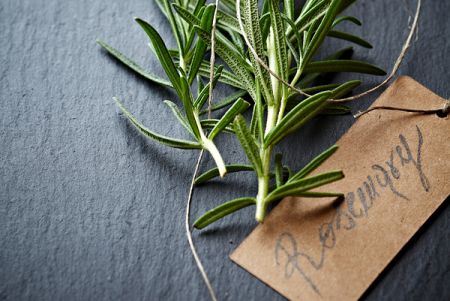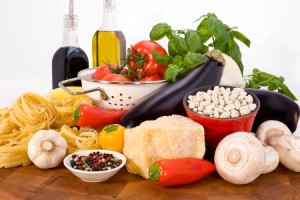One of the most nutritious foods are so-called everyday herbs and spices – unassuming ingredients used in recipes to add flavor, but which offer so much more than that. Fresh and dried herbs and spices offer a plethora of healthful compounds called phytonutrients, which go far beyond just improving the taste of your food.
Rosemary has a rich history

As one of the most versatile plants around – with uses ranging from aromatherapy to cuisine to medicine – rosemary, or Rosmarinus officinals, has been revered by various cultures, from as far back as the ancient Egyptians and Greeks, to the Romans to medieval Spain to Renaissance era Hungary and England. Originating in areas of the Mediterranean and Asia, the plant has spread throughout Europe, North America, and Mexico.
Cooking with rosemary
As a hardy evergreen perennial plant, rosemary can be harvested year round, making it easy to use as a fresh herb; alternatively its needle-like leaves can be used dried as well. Because it has a strong flavor, you only need a small amount, even in dishes that are slow cooked, as the flavor is very stable.
The more traditional uses of rosemary are with lamb and with vegetables, particularly roasted root vegetables, summer squashes, and tomatoes. A particularly robust and versatile seasoning combination is of rosemary and garlic, with or without olive oil, lemon zest, or lemon juice.
Throw a sprig or two into a bottle of olive oil for some beautifully rosemary-infused oil, which can be used in almost any recipe where you would normally use regular olive oil.
Rosemary complements many other herbs, as well, including bay leaf, chives, mint, oregano, parsley, sage, savory, and thyme.
Healing with rosemary
Like all herbs and spices, rosemary is rich in innumerable compounds collectively called ‘phytonutrients,’ suggested to have health-promoting properties, primarily antioxidative. These include volatile oils and secondary phytonutrients, such as rosmarinic acid, cineol, camphene, borneol, carnosol and carnosic acid – among others that nutritional science is still figuring out.
Historically, rosemary has been used to improve memory, relieve muscle pain, and stimulate the nervous system. Currently it is considered an analgesic, antiseptic, antidepressant, an anti-inflammatory, expectorant, antiviral, and natural disinfectant.
Its purported stimulating, antiseptic, and diuretic properties make it a popular tonic. It has been suggested to help stimulate bile secretion, which when bound to dietary fiber, helps to eliminate toxins from the body.
In herbal medicine, this aromatic plant is used to treat a variety of ailments, including indigestion, liver disease, gastritis, high cholesterol, bronchitis, asthma, edema, constipation, colds, coughs, sinusitis, and more.
Nutritional properties of rosemary
In addition to phytonutrients, rosemary has an impressive amount of iron and beta carotene, also known as pro-vitamin A: each gram of fresh rosemary (just over a teaspoon) yields nearly a full percent of the Recommended Daily Allowance (RDA) for each – surprisingly high for ‘just’ a seasoning.
Storing rosemary
Fresh rosemary is considered to be more desirable than dried, because it has a more subtle flavor. It should be stored in the refrigerator inside a plastic bag.
Dried rosemary works well, too, but because the water has been removed, the flavors are more concentrated, stronger, and more pungent – a little goes a long way. The advantage, however, is that it can be kept usable for a longer period of time than the fresh plant. Dried rosemary should be kept in a cool, dark, and dry place in an airtight container to protect it from oxidation – in these conditions, it will keep for several months.
To learn more about the Trim Down Club’s healthy eating plan, click here.
*Source: USDA National Nutrient Database




My mouth is watering @alliegirl
Scallop Recipe:
I’m fortunate to have a lush rosemary “shrub” in my kitchen. My favorite recipe is to mix equal parts of fresh chopped rosemay and paprika, a dash of cayenne pepper and coat sea scallops with this.Don’t forget a little salt & pepper. I then pan sear the scallops and serve with a salad and whatever else you’d enjoy!
I fix a cornish hen with a sprig of rosemary in the cavity along with 1/4 of a orange, and Hungarian Paprika. You squeeze the orange juice over the hen and sprinkle Hungarian paprika lightly over the bird. Roast hen at 400* for about 45min-1 hour or until juices run clear. I grow rosemary in my garden!
I grow it in my garden and have it all year round.
@christinemary – fresh and dried herbs have never needed to be avoided by those with high blood pressure to my knowledge or in my experience
@amethyst707I’ve never tried to freeze my herbs and no clue about fresh equivalents, not sure if/how freezing it will alter the flavor/use
yes it freezes quite well.i freeze other herbs as well . It is handy in an emmergency
would suggest that Rosemary is used during the day rather than in the evening, as the stimulant effect may compromise sleep
Can you freeze rosemary if yes, would it be equivalent to fresh?
can you use rosemary if you have high blood pressure?